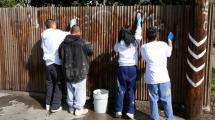Youth who receive special education services under the Individuals with Disabilities Education Act (IDEA 2004) and especially young adults of transition age, should be involved in planning for life after high school as early as possible and no later than age 16. Transition services should stem from the individual youth’s needs and strengths, ensuring that planning takes into account his or her interests, preferences, and desires for the future.
Educating Youth
Schools and youth-serving programs can provide key venues for youth to learn about disaster preparedness and response. Research suggests that trainings focused on disaster preparedness can result in behavior changes, and that youth who are prepared are more confident and feel empowered during an actual emergency.1 Further, youth involved in multiple educational programs targeted at hazard education have been found to have significantly more knowledge about disasters and disaster preparedness than youth who participated in just one program.2
Important considerations for educating and preparing youth for disasters:
- Be realistic: The use of scare tactics has been found to be an ineffective approach for disaster preparation.3 In contrast, providing realistic information about disasters and coping mechanisms has been found to be an effective approach. Specifically, researchers found that youth with unrealistic disaster risk perceptions were more likely to be afraid of disasters, believe less in their ability to cope, and be less aware of protective behaviors in comparison to youth with more realistic perceptions.4 Further, providing youth with opportunities to become familiar with police officers and emergency personnel can minimize fear or uncertainty. Therefore youth preparedness programs that enable first responders to work with youth can help to cultivate positive relationships and help youth to understand that first responders play a positive role in their communities.5
- Be youth-focused: Programs should focus on youth needs, include their voices, and delineate the role that youth play in a disaster. The focus should not be the same for youth and adults. Programs should use age-appropriate instructional practices.6
- Be creative: Utilizing creative methods that include the use of interactive visual aids and opportunities where youth can be actively involved in experiential learning have been found to be related to knowledge of preparedness.7 View an example of a creative approach to disaster preparedness.
- Integrate into the curriculum: Disaster preparedness can be integrated into school curricula across subject matter. Disaster preparedness can be incorporated into science, history, economics, social studies, language arts, and mathematics courses. Teachers can also incorporate real world events to teach about disasters and emergency situations.8 View a catalogue of examples of education resources.
- Engage families: Youth preparedness programs should promote interaction between youth and their families. For example, programs can help to ensure families have developed disaster preparedness plans and kits, and that youth are involved and knowledgeable about these efforts.9 Learn more about what schools, youth programs, and families can do to plan for disasters.
Tools for Youth Preparedness Programs
Youth Preparedness Fact Sheet
This one-page fact sheet provides an overview of the importance of youth preparedness, as well as information about how FEMA and other organizations support it.
Youth Preparedness: Implementing a Community-Based Program
This document provides information about high-level steps for implementing a youth preparedness program.
Catalogue of Youth Disaster Preparedness Education Resources
This document identifies existing programs, curricula, and resources that may be of interest to those starting, or interested in finding, youth preparedness programs.
Youth Preparedness Program Implementation Workbook
This workbook helps program managers brainstorm and implement each of the steps discussed in Youth Preparedness: Implementing a Community-Based Program.
Youth Preparedness Program Implementation Checklist
This checklist helps program managers ensure that they have thoroughly completed each of the steps discussed in Youth Preparedness: Implementing a Community-Based Program.
Youth Preparedness Funding Guide
This document provides information about securing funding and resources to begin and sustain a program.
Youth Preparedness Quick Tips to Mitigate Risks
This document provides a brief overview of basic strategies to manage key risks that a program might face.
Youth Preparedness Guide to Risk Management
This document helps program managers identify potential risks associated with their programs and techniques to mitigate those risks.
FEMA Youth Preparedness Technical Assistance Center
This Technical Assistance Center is available to assist youth preparedness practitioners and is accessible via FEMA-Youth-Preparedness@fema.dhs.gov.
Resources
Children and Disasters Newsletter
The Children and Disasters Newsletter contains updates about various youth-related initiatives, research, and events, and is available to anyone interested in topical updates related to youth preparedness. To subscribe to the newsletter, please visit the registration page.
Technical Assistance
FEMA provides technical assistance directly to youth preparedness practitioners who request tools, information, and advice about program implementation, as well as others who have general questions about youth preparedness. The Technical Assistance Center is accessible via FEMA-Youth-Preparedness@fema.dhs.gov.
Ready…Set…Prepare! A Disaster Preparedness Activity Book (Ages 4-7) (PDF, 42 pages)
This document provides activities and games that can help children and families get prepared.
Ready…Set…Prepare! A Disaster Preparedness Activity Book (Ages 8-11) (PDF, 40 pages)
This document provides activities and games that can help children and families get prepared.
Ready.gov
This site provides information and resources about disasters and disaster preparedness. It includes a section focused on kids, an interactive site with kid-friendly information, activities, and games focused on disaster preparedness, including making a plan and assembling disaster preparedness kits. It also includes resources and information for parents and teachers to support disaster preparedness education.
FEMA Preparedness Tips for Parents and Guardians
This resource contains tailored, practical suggestions on preparedness and links to tools and resources for parents and guardians. Resources are pulled from FEMA, the Department of Education, CDC, and practitioners in the field. This resource helps parents and guardians better understand school emergency policies and will not only help parents and guardians recognize what safety measures are being offered in school, but it can also highlight areas where they can bolster their own emergency planning.
American Red Cross and FEMA: Helping Children Cope with Disaster (PDF, 12 pages)
This booklet was created to assist parents and caregivers in helping youth cope with disasters and emergencies. The guide also provides information on preparing family emergency plans and discussing these plans with youth.
Bringing Youth Preparedness Education to the Forefront: A Literature Review and Recommendations
Recognizing the need for research to evaluate the current state of disaster preparedness education and research regarding youth, the Federal Emergency Management Agency (FEMA) commissioned a review of the literature related to emergency preparedness education for youth. The objectives of this review were to identify research and evaluations of youth education interventions for emergency preparedness and to use the findings to develop recommendations that can be used to assess current programs and to enhance the provision of youth preparedness education programs.
Teen CERT: Community Emergency Response Team
The Teen CERT training program teaches youth readiness and response skills. Hands-on practice and realistic exercises prepare youth for the unexpected in their community. Newly learned leadership skills will empower youth to safely respond to an emergency and assist victims without endangering themselves or others.
ED Office of Safe and Healthy Students Emergency Planning Website
The U.S. Department of Education (ED)'s Office of Safe and Healthy Students' (OSHS) Center for School Preparedness provides support, resources, grants, and training to support emergency management efforts for local educational agencies and institutions of higher education.
The Readiness and Emergency Management for Schools (REMS) Technical Assistance Center
The REMS Technical Assistance Center supports public and non-public schools, school districts, and institutions of higher education in school emergency management, including the development and implementation of comprehensive all-hazards emergency management plans. The TA Center disseminates information about school emergency management to help individual schools, school districts, and institutions of higher education learn more about developing, implementing, and evaluating comprehensive, all-hazards school emergency management plans.
CDC Emergency Preparedness and Response Website
This website is CDC’s primary source of information and resources for preparing for and responding to public health emergencies. This site continues to keep the public informed about public health emergencies and provides the information needed to protect and save lives. The site features specific information and resources focused on different types of disasters including bioterrorism, chemical emergencies, natural disasters, radiation emergencies, mass casualties, and others.
CDC Emergency Preparedness and You
The possibility of public health emergencies arising in the United States concerns many people in the wake of recent hurricanes, tsunamis, acts of terrorism, and the threat of pandemic influenza. Taking advance action helps people deal with disasters of all sorts much more effectively when they do occur. To help, CDC and the American Red Cross have teamed up to answer common questions and provide step-by-step guidance.
CDC Preparedness Resources for Schools
Schools and education agencies cannot prevent natural disasters, or even many man-made crises, but they can help students prepare for and plan to respond to such emergencies. Resources are available to help schools, education agencies, and institutions of higher education develop such plans, usually in collaboration with public health and first responder agencies.
Preparing for Disasters and Disruptions to Service Continuity
Preparing for disasters involves creating plans, preparing to manage during a disaster, and enhancing critical infrastructure prior to a disaster. In this section of the Child Welfare Information Gateway, you will find federal and state resources for professionals and families to prepare for disasters—both natural (e.g., hurricanes, floods, fires) and human created (e.g., terrorism)—including examples of state disaster plans.
1 Corrarino, Walsh, & Nadel, 2001
2 Ronan and Johnston, 2001
3 U.S. Department of Homeland Security, 2010; Beck, 1998
4 Ronan and Johnston, 2001
5 U.S. Department of Homeland Security, n.d.
6 U.S. Department of Homeland Security, 2010
7 U.S. Department of Homeland Security, 2010; Peek, 2008
8 Fuhrmann et al., 2008; U.S. Department of Homeland Security, 2010
9 Ronan and Johnston, 2001
Youth Briefs
Research links early leadership with increased self-efficacy and suggests that leadership can help youth to develop decision making and interpersonal skills that support successes in the workforce and adulthood. In addition, young leaders tend to be more involved in their communities, and have lower dropout rates than their peers. Youth leaders also show considerable benefits for their communities, providing valuable insight into the needs and interests of young people
Statistics reflecting the number of youth suffering from mental health, substance abuse, and co-occurring disorders highlight the necessity for schools, families, support staff, and communities to work together to develop targeted, coordinated, and comprehensive transition plans for young people with a history of mental health needs and/or substance abuse.
Nearly 30,000 youth aged out of foster care in Fiscal Year 2009, which represents nine percent of the young people involved in the foster care system that year. This transition can be challenging for youth, especially youth who have grown up in the child welfare system.
Research has demonstrated that as many as one in five children/youth have a diagnosable mental health disorder. Read about how coordination between public service agencies can improve treatment for these youth.
Civic engagement has the potential to empower young adults, increase their self-determination, and give them the skills and self-confidence they need to enter the workforce. Read about one youth’s experience in AmeriCorps National Civilian Community Corps (NCCC).






